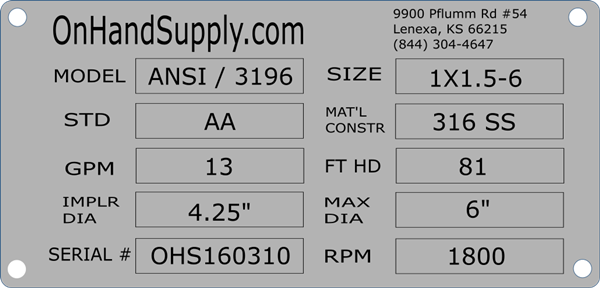
Here's an example of a pump serial plate from OnHandSupply. Serial plates may differ by each manufacturer, but the fields are generally similar. There may be an additional serial plate on the motor, which is specific to the motor used to power the pump. The serial plate for the pump may be on the power end (bearing housing) or the casing (volute).
It's important to familiarize yourself with the fields on a serial plate, because your serial plate is the easiest way to gain key information about your pump. We'll cover the definition of each field on the serial plate.
- COMPANY
- The company name on the serial plate may be the pump OEM (Original Equipment Manufacturer) brand name, the name of the pump packager, or the name of a private label company. This is the only entity that can interpret the serial number assigned to the pump.
- MODEL #
- A model number identifies the type of pump. This might be a generic term like "ANSI," or a model number specific to a brand. A model number that is brand specific, like a Goulds "3196," indicates that the pump is from the Goulds' ANSI line. A brand and model specific number is far more helpful, because it determines whether or not parts interchange with other brands. Besides the Goulds 3196, other ANSI brand models include: Summit 2196, Peerless 8196, Griswold 811, Aurora 3550, and others
- STD
- ANSI designation. This identifies the dimensions of the pump according to ANSI standards. The standard number is not unique to each ANSI pump size, but all pump sizes with the same ANSI designation will have the same pump dimensions (pump can be replaced without changing the base or piping).
- GPM
- This is the flowrate of the process fluid being pumped, in gallons per minute.
- IMPLR DIA
- Impeller Diameter is the diameter of the impeller that the pump was designed to operate to achieve best efficiency for a given application. Note that this may be less than the maximum impeller diameter which corresponds to its size. If the impeller does not need to be trimmed down, the impeller diameter may say "Full" to indicate that no trimming is necessary.
- SERIAL #
- This is a unique identifier for the pump that only the manufacturer or packager can interpret. From the serial number, every part of the pump should be identifiable for reorder; however, a pump can undergo modifications over its life which the original manufacturer may not have on file. We recommend double checking key measurements to verify the information from pump serial numbers.
- SIZE
- The size of the pump contains significant information. It contains three numbers, typically written like '2x3-13'. The first two numbers are the suction and discharge opening dimensions. The order is not important, although each brand has a preference. The smaller number is the discharge, and the bigger number is the suction. The last number is the maximum impeller diameter. Note that the actual impeller diameter may be deliberately trimmed to fit the pump application, or unintentionally less than the max diameter due to wear.
- MAT'L CONSTR
- Materials of construction. This is typically the material of the “wet end” parts, or the parts that come in contact with the process fluid (impeller, rear cover/stuffing box and casing/volute. These parts may need to be more corrosion resistant than other parts of the pump that are not wetted by the process fluid. Common materials include cast or carbon steel (CS), cast iron (CI), 316 stainless steel (316 SS), CF8M (the cast equivalent of machined 316 stainless steel) and CD4MCuN. There are more exotic alloys available such as Hastelloy C, Hastelloy B, Alloy 20 or titanium for extreme applications.
- FT HD
- Feet of Head. This is the height of the column of the process fluid that the pump can maintain. Feet of Head can be converted to psi (pounds per square inch) = 0.433 * specific gravity of the process fluid. In most cases, feet of head is approximately twice the psi.
- MAX DIA
- Maximum diameter of the impeller. Often not necessary because this information is implied by the pump size.
- RPM
- Revolutions per minute. ANSI pumps commonly turn at 1800 or 3600 rpm.
